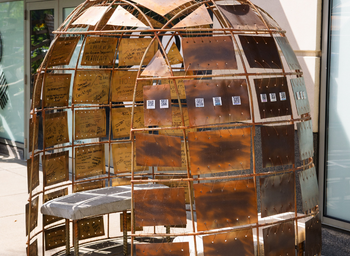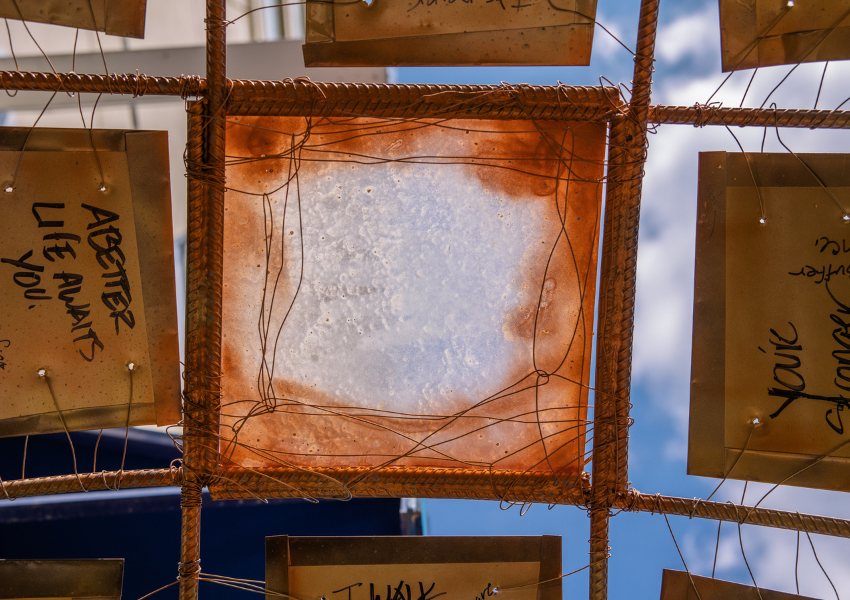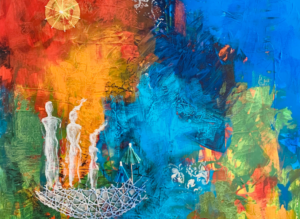Standing Against Domestic Violence Through Public Art
Published Nov 22, 2022

Zoongide'e (Ojibwe: he/she has a brave heart)

Artist Statement:
Through the strength of metal and fragility of glass, I seek to construct a beacon and a sanctuary. Domestic violence is a topic which no one approaches lightly. In my own experiences, I found that the sense of aloneness made it the most difficult to seek help, and when I was able to seek assistance, it was difficult to find. By gaining the courage to change things, I found a sense of home and sanctuary for the first time. The Wigwam is a traditional home for most Northern Indigenous tribes, of which I am a part. The sculpture will mirror the construction of a traditional wigwam and create a place where people can sit, reflect and find or give assistance. My hope is to provide a sense of support and inspiration for those seeking strength, to inspire people to find safety and inspire others to help make a change. The sculpture itself be an interplay of glass and metal creating warmth when you enter the structure through the light it allows inside.
Created in partnership with National Indigenous Women’s Resource Center and MassNOW for Be the Change.
“Zoongide’e (Ojibwe: he/she has a brave heart)” is on loan at the Ziibiwing Center in Mount Pleasant, Michigan from September 25, 2020 to May 5, 2021.
Nayana LaFond is a professional artist, curator, and Artivist living and working in Western Massachusetts with her daughter. Nayana attended Greenfield Community College for Fine Art and Massachusetts College of Art for Photography. Nayana has been curating for over 15 years, including as chief curator for the Whitney Center for the Arts. She sits on several boards, including Artist Organized Art, and is an Advisory member for the Native Youth Empowerment Fund. Nayana’s work has always come from a place of trauma, healing, and activism and can be seen in museums and private collections around the world. Her series of paintings titled “Portraits in RED, The Missing & Murdered Indigenous Peoples painting project” will be going on tour through the Emerson Museum starting in 2022 until at least 2025 and a number of solo exhibitions of the collection are scheduled for 2022 through 2024.
Be the Change Walking Tour Recording: Nayana LaFond
(1 min) Listen to Nayana LaFond describe her piece for the Be the Change Walking Tour.
Discussion: Transgender Equality for BIPOC Youth and Domestic Violence
(1 hour 4 min) An online discussion featuring 2 of the 6 Boston-based Be the Change artists, Samuel Mendoza and Nayana LaFond, in conversation with leading experts Rabbi Claudia Kreiman, Idit Klein, and Elizabeth Schön Vainer.
Rabbi Claudia Kreiman, Senior Rabbi of Temple Beth Zion in Brookline, MA, is a tireless advocate for women’s issues as well as for the LGBTQ+ community.
Idit Klein, President and CEO of Keshet, works for the full equality of all LGBTQ Jews and our families in Jewish life. Keshet equips Jewish organizations with the skills and knowledge to build LGBTQ-affirming communities, create spaces in which all queer Jewish youth feel seen and valued, and advance LGBTQ rights nationwide.
Elizabeth Schön Vainer, Program Director of Journey to Safety, the JF&CS response to domestic abuse, works to prevent domestic abuse in the Jewish community while helping those who have been abused find their way to safety, regardless of their background or beliefs.
If you are in need of assistance, please reach out to Journey to Safety:
(781) 647-5327 x1213
jts@jfcsboston.org
SafeLink (24/7 Statewide Hotline)
(877) 785-2020
Zoongide'e (Ojibwe: he/she has a brave heart)

Above: A view of the top of the structure, from the inside looking up.
Zoongide'e (Ojibwe: he/she has a brave heart)

Above: A view of the inside of the structure, with messages written in several languages.
Learn more about Be the Change and check out other work from Be the Change Boston 2022:
Our Family Tree – Jason Talbot
Healing Garden – Ngoc-Tran Vu
It’s Giving – Sam Mendoza Fraiman
Prisoner a-7713 – Caron Tabb
Vital Organs – Carolyn Lewenberg
JArts’ mission is to curate, celebrate, and build community around the diverse world of Jewish arts, culture, and creative expression. Our vision is of a more connected, engaged, and tolerant world inspired by Jewish arts and culture.
Reflections
Domestic Violence
Domestic Violence is common. 1 in 3 women and 1 in 4 men have experienced some form of physical violence by an intimate partner.
About 41% of women and 26% of men experienced contact sexual violence, physical violence, and/or stalking by an intimate partner and reported an intimate partner violence-related impact during their lifetime. Injury, posttraumatic stress disorder (PTSD) symptoms, concern for safety, fear, needing help from law enforcement, and missing at least one day of work are common impacts reported.
Would you know how to recognize the signs of Domestic Violence in someone? What are some indicators that would show someone might be experiencing abuse?
What steps would you take if you suspected someone you knew was in an abusive relationship?
The lifetime economic cost associated with medical services for IPV-related injuries, lost productivity from paid work, criminal justice and other costs, is $3.6 trillion. The cost of IPV over a victim’s lifetime was $103,767 for women and $23,414 for men.
According to the CDC, domestic violence can be prevented when a victim has financial security, social support systems, survivor support resources, work family support programs, prevention education, and screening programs. How can we ensure that more people are protected by these resources?
Who is affected by domestic violence the most?
Women between the ages of 18-24 are most commonly abused by an intimate partner. 19% of domestic violence involves a weapon. Domestic victimization is correlated with a higher rate of depression and suicidal behavior. Only 34% of people who are injured by intimate partners receive medical care for their injuries.
Domestic violence affects everyone, but tends to be more prevalent in marginalized communities. How can we ensure that all victims have access to resources that can help them get out of an abusive environment?
Even with low reporting, though, the number of women of color who are impacted by domestic violence is shockingly high. In fact, according to the National Intimate Partner and Sexual Violence Survey, approximately four out of 10 non-Hispanic Black women, American Indian, or Alaskan Native women, and one in two multi-racial non-Hispanic women have been a victim of physical violence, rape, and/or stalking by a partner in their lifetime.
This rate is 30 to 50% higher than what is experienced by White non-Hispanic, Hispanic, and Asian women.
Want more?
Get curated JewishArts.org content in your inbox


